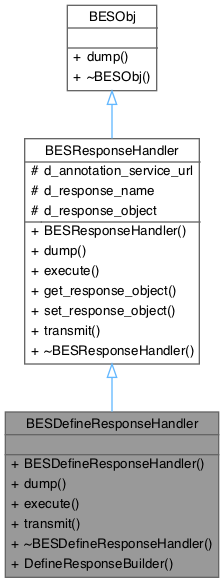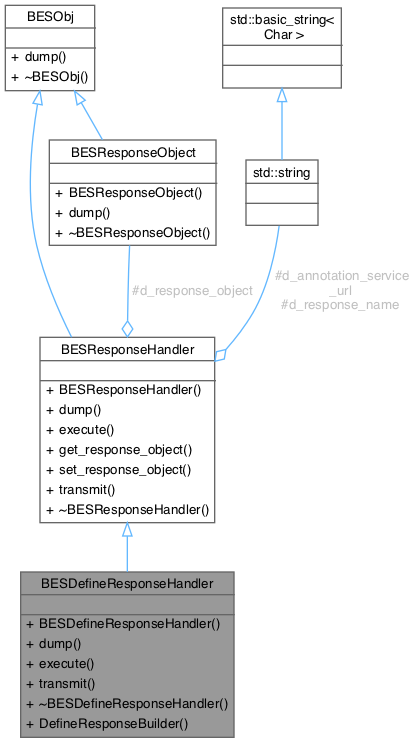response handler that creates a definition given container names and optionally constraints and attributes for each of those containers. More...
#include <BESDefineResponseHandler.h>


Public Member Functions | |
| BESDefineResponseHandler (const std::string &name) | |
| virtual void | dump (std::ostream &strm) const |
| dumps information about this object | |
| virtual void | execute (BESDataHandlerInterface &dhi) |
| executes the command to create a new definition. | |
| virtual BESResponseObject * | get_response_object () |
| return the current response object | |
| virtual BESResponseObject * | set_response_object (BESResponseObject *o) |
| replaces the current response object with the specified one, returning the current response object | |
| virtual void | transmit (BESTransmitter *transmitter, BESDataHandlerInterface &dhi) |
| The Define command does not return a response. | |
Static Public Member Functions | |
| static BESResponseHandler * | DefineResponseBuilder (const std::string &name) |
Protected Attributes | |
| std::string | d_annotation_service_url |
| std::string | d_response_name |
| BESResponseObject * | d_response_object = nullptr |
Detailed Description
response handler that creates a definition given container names and optionally constraints and attributes for each of those containers.
A request looks like:
define <def_name> as <container_list>
[where <container_x>.constraint="<constraint>"]
[,<container_x>.attributes="<attrs>"]
[aggregate by "<aggregation_command>"];
where container_list is a list of containers representing points of data, such as a file. For each container in the container_list the user can specify a constraint and a list of attributes. You need not specify a constraint for a given container or a list of attributes. If just specifying a constraint then leave out the attributes. If just specifying a list of attributes then leave out the constraint. For example:
define d1 as container_1,container_2
where container_1.constraint="constraint1"
,container_2.constraint="constraint2"
,container_2.attributes="attr1,attr2";
It adds the new definition to the list. If a definition already exists in the list with the given name then it is removed first and the new one is added. The definition is currently available through the life of the server process and is not persistent.
- See also
- BESDefine
- DefintionStorageList
- BESContainer
- BESTransmitter
Definition at line 76 of file BESDefineResponseHandler.h.
Constructor & Destructor Documentation
◆ BESDefineResponseHandler()
| BESDefineResponseHandler::BESDefineResponseHandler | ( | const std::string & | name | ) |
Definition at line 49 of file BESDefineResponseHandler.cc.
◆ ~BESDefineResponseHandler()
|
virtual |
Definition at line 54 of file BESDefineResponseHandler.cc.
Member Function Documentation
◆ DefineResponseBuilder()
|
static |
Definition at line 130 of file BESDefineResponseHandler.cc.
◆ dump()
|
virtual |
dumps information about this object
Displays the pointer value of this instance
- Parameters
-
strm C++ i/o stream to dump the information to
Implements BESObj.
Definition at line 121 of file BESDefineResponseHandler.cc.
◆ execute()
|
virtual |
executes the command to create a new definition.
A BESDefine object is created and added to the list of definitions. If a definition already exists with the given name then it is removed and the new one added.
The BESDefine object is created using the containers, constraints, attribute lists and aggregation command parsed in the parse method.
- Todo
- Roll this command's execute() method into the XMLDefineCommand::parse_request() method using the NullResponseObject.
- Parameters
-
dhi structure that holds request and response information
- Exceptions
-
BESSyntaxUserError if the store name specified does not exist
- See also
- BESDataHandlerInterface
- BESDefine
- DefintionStorageList
Implements BESResponseHandler.
Definition at line 76 of file BESDefineResponseHandler.cc.
◆ get_response_object()
|
virtualinherited |
return the current response object
Returns the current response object, null if one has not yet been created. The response handler maintains ownership of the response object.
- Returns
- current response object
- See also
- BESResponseObject
Definition at line 62 of file BESResponseHandler.cc.
◆ set_response_object()
|
virtualinherited |
replaces the current response object with the specified one, returning the current response object
This method is used to replace the response object with a new one, for example if during aggregation a new response object is built from the current response object.
The caller of set_response_object now owns the returned response object. The new response object is now owned by the response object.
- Parameters
-
o new response object used to replace the current one
- Returns
- the response object being replaced
- See also
- BESResponseObject
Definition at line 68 of file BESResponseHandler.cc.
◆ transmit()
|
virtual |
The Define command does not return a response.
- Parameters
-
transmitter object that knows how to transmit specific basic types dhi structure that holds the request and response information
Implements BESResponseHandler.
Definition at line 111 of file BESDefineResponseHandler.cc.
Member Data Documentation
◆ d_annotation_service_url
|
protectedinherited |
Definition at line 82 of file BESResponseHandler.h.
◆ d_response_name
|
protectedinherited |
Definition at line 79 of file BESResponseHandler.h.
◆ d_response_object
|
protectedinherited |
Definition at line 80 of file BESResponseHandler.h.
The documentation for this class was generated from the following files: